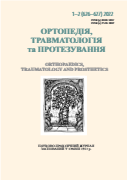Effectiveness of resisting torsional loads of various options for osteosynthesis of tibial fragments (according to the results of mathematical modeling)
DOI:
https://doi.org/10.15674/0030-598720221-234-42Keywords:
Tibia, fracture, torsion, osteosynthesisAbstract
Recently, there has been a trend towards high statistical indicators of the number of bone fractures of the lower limbs
(47.3%), of which diaphyseal fractures of the lower leg bones make up 45‒56 %. Objective. Conduct a comparative analysis
of the stress-strain state of leg models with a fracture of the tibia under the torsional loading combined with various options
of osteosynthesis and depending on the patient's weight. Methods. A fracture was modeled in the middle third of the diaphysis
of the tibia and three types of osteosynthesis — with the help of an external apparatus fixation (EAF), periosteal plate and
intramedullary rod Bones were attached to the tibial plateau torque of 7 Nm and 12 Nm. Results. It was determined that
the changes in stress levels in bone tissue depend linearly on the patient's weight. Under simulation conditions stabilization
of the fracture with the help of EAF and intramedullary stress rod in the fracture area were found significantly lower
than the level of indicators of intact bone. In this same zone in the model with a bony plate, the value stress levels were lower
than the intact model bone, but with an increase in the patient's weight to 120 kg, these indicators almost leveled off. The highest stress level was recorded in the distal part of the tibia in the model with intramedullary rod osteosynthesis, and in
the proximal one, the stresses that exceeded the parameters of the model with intact bone were determined under the conditions use of EAF. The largest in metal structures stress is detected in the periosteal plate. Conclusions. The highest stresses in the fracture zone (5.8‒9.9 MPa) and on the metal structure (360.0‒617.0 MPa) was recorded in a model with a bone plate. In the model with EAF in the zone of the fracture, the stresses were at the level of 0.1‒0.2 MPa, in the proximal part of the tibia — 6.3‒10.8 MPa, in the model with an intramedullary rod — 0.1‒0.2 MPa and 0.5‒0.9 MPa, respectively. In the distal part
of the stress in the last model remained high — 11.7‒20.1 MPa.
References
- Hayko, G.V., Kalashnikov, A.V., Boer, V.A. [and others] (2016). Diaphyseal fractures in the structure of traumatism of the population of Ukraine: Abstracts of reports of the XIV Congress of Orthopedic Traumatologists of Ukraine. Odesa, 9–10 (in Ukrainian)
- Yermolenko N. O., Zarudna, O. I., Holyk, I. V. (2016). Obesity – the problem of modernity. Nursing, (1). doi:10.11603/2411-1597.2016.1.7385
- World Health Organization. The issue of obesity (n.d.). Retrieved from https://www.who.int/ru/news-room/fact-sheets/detail/obesity-and-overweight
- Popsuishapka, O., Litvishko, V., Uzhegova, O., & Pidgaiska, O. (2020). Frequency of complications at shaft fractures according to Kharkiv traumatological medical-social expert committee (MSЕC) data. ORTHOPAEDICS, TRAUMATOLOGY and PROSTHETICS, 0(1), 20-25. doi:10.15674/0030-59872020120-25
- Litvishko, V., Popsuishapka, O., & Yaresko, O. (2016). Stress-strain state of fibrin-blood clot and periosteum in the area of diaphyseal fracture under different conditions of fracture fragments fixation and its impact on the structural organization of regenerate. ORTHOPAEDICS, TRAUMATOLOGY and PROSTHETICS, 0(1), 62. doi:10.15674/0030-59872016162-71
- Berezovsky, V. A., Kolotilov, N. N. (1990). Biophysical characteristics of human tissues: Reference. Kyiv: Naukova dumka. (in Ukrainian)
- Vasyuk, V., Koval, O., Karpinsky, M., & Yaresko, O. (2021). Mathematical modeling of options for osteosynthesis of distal tibial metaphyseal fractures type C1. TRAUMA, 20(1), 28–37. https://doi.org/10.22141/1608-1706.1.20.2019.158666. (in Ukrainian)
- M. O. Korzh, K. K. Romanenko, D. V. Prozorovskyi Yaresko O. V. (2016). Mathematical modeling of the influence of the deformation of the bones of the lower leg on the load on the joints of the lower limb. Trauma, 17 (3), 23‒24. (in Ukrainian)
- Stoyko, I., Bats, V., Karpinsky М., & Bats, I. (2014). Analysis of Stress-Strain State of the Distal Tibia and Foot in Pilon Injuries Under External Fixation using Rod Devices. TRAUMA, 15(1), 41–49. https://doi.org/10.22141/1608-1706.1.15.2014.81263. (in russian)
- Gere, J. M., Timoshenko, S. P. (1997). MechanicsofMaterial.
- Zenkevich, O. K. (1978). Finite element method in engineering. Moscow: Mir. (in russian)
- Alyamovsky, A. A. (2004). SolidWorks/COSMOSWorks. Engineering analysis by the finite element method. Moscow: DMK Press. (in russian)
Downloads
How to Cite
Issue
Section
License

This work is licensed under a Creative Commons Attribution 4.0 International License.
The authors retain the right of authorship of their manuscript and pass the journal the right of the first publication of this article, which automatically become available from the date of publication under the terms of Creative Commons Attribution License, which allows others to freely distribute the published manuscript with mandatory linking to authors of the original research and the first publication of this one in this journal.
Authors have the right to enter into a separate supplemental agreement on the additional non-exclusive distribution of manuscript in the form in which it was published by the journal (i.e. to put work in electronic storage of an institution or publish as a part of the book) while maintaining the reference to the first publication of the manuscript in this journal.
The editorial policy of the journal allows authors and encourages manuscript accommodation online (i.e. in storage of an institution or on the personal websites) as before submission of the manuscript to the editorial office, and during its editorial processing because it contributes to productive scientific discussion and positively affects the efficiency and dynamics of the published manuscript citation (see The Effect of Open Access).














